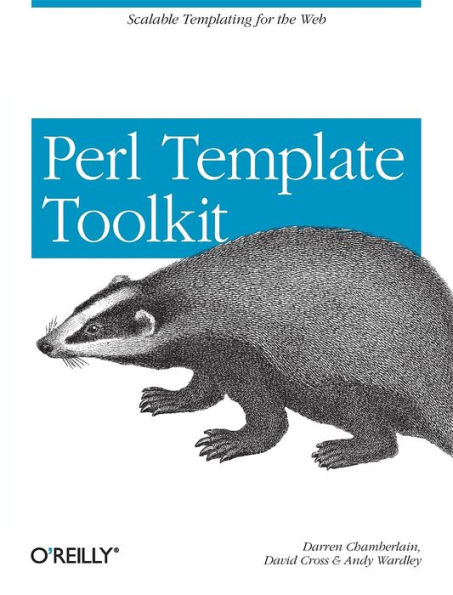5
1

Perl Template Toolkit: Scalable Templating for the Web
590
by Darren Chamberlain, David Cross, Andy Wardley
Darren Chamberlain

Perl Template Toolkit: Scalable Templating for the Web
590
by Darren Chamberlain, David Cross, Andy Wardley
Darren Chamberlain
Paperback
$39.99
-
PICK UP IN STORECheck Availability at Nearby Stores
Available within 2 business hours
Related collections and offers
39.99
In Stock
Overview
Among the many different approaches to "templating" with Perl—such as Embperl, Mason, HTML::Template, and hundreds of other lesser known systems—the Template Toolkit is widely recognized as one of the most versatile. Like other templating systems, the Template Toolkit allows programmers to embed Perl code and custom macros into HTML documents in order to create customized documents on the fly. But unlike the others, the Template Toolkit is as facile at producing HTML as it is at producing XML, PDF, or any other output format. And because it has its own simple templating language, templates can be written and edited by people who don't know Perl. In short, the Template Toolkit combines the best features of its competitors, with ease-of-use and flexibility, resulting in a technology that's fast, powerful and extensible, and ideally suited to the production and maintenance of web content and other dynamic document systems. In Perl Template Toolkit you'll find detailed coverage of this increasingly popular technology. Written by core members of the technology's development team, the book guides you through the entire process of installing, configuring, using, and extending the Template Toolkit. It begins with a fast-paced but thorough tutorial on building web content with the Template Toolkit, and then walks you through generating and using data files, particularly with XML. It also provides detailed information on the Template Toolkit's modules, libraries, and tools in addition to a complete reference manual. Topics in the book include:
- Getting started with the template toolkit
- The Template language
- Template directives
- Filters
- Plugins
- Extending the Template Toolkit
- Accessing databases
- XML
- Advanced static web page techniques
- Dynamic web content and web applications

Product Details
| ISBN-13: | 9780596004767 |
|---|---|
| Publisher: | O'Reilly Media, Incorporated |
| Publication date: | 12/28/2003 |
| Pages: | 590 |
| Product dimensions: | 7.00(w) x 9.19(h) x 1.27(d) |
About the Author
Darren Chamberlain is an active member of the Template Toolkit development team.
David Cross is the owner of Magnum Solutions Ltd., a London-based Perl Consultancy, and is also the author of the well-respected Data Munging with Perl.
Andy Wardley is the author of several CPAN modules including the Template Toolkit. He is a software researcher at the Canon Research Centre Europe and specializes in web-related technologies including dynamic content generation, web application frameworks, and the customization and localization of user interfaces and web content.
David Cross is the owner of Magnum Solutions Ltd., a London-based Perl Consultancy, and is also the author of the well-respected Data Munging with Perl.
Andy Wardley is the author of several CPAN modules including the Template Toolkit. He is a software researcher at the Canon Research Centre Europe and specializes in web-related technologies including dynamic content generation, web application frameworks, and the customization and localization of user interfaces and web content.
Table of Contents
Preface; Audience; About this Book; Conventions Used in This Book; Comments and Questions; Acknowledgments; Chapter 1: Getting Started with the Template Toolkit; 1.1 What the Template Toolkit Does; 1.2 The Templating Ecosystem; 1.3 Installing the Template Toolkit; 1.4 Documentation and Support; 1.5 Using the Template Toolkit; 1.6 The Template Toolkit Language; 1.7 Template Variables; 1.8 Template Directives; 1.9 Integrating and Extending the Template Toolkit; Chapter 2: Building a Complete Web Site Using the Template Toolkit; 2.1 Getting Started; 2.2 Template Components; 2.3 Defining Variables; 2.4 Generating Many Pages; 2.5 Adding Headers and Footers Automatically; 2.6 More Template Components; 2.7 Wrapper and Layout Templates; 2.8 Menu Components; 2.9 Defining and Using Complex Data; 2.10 Assessment; Chapter 3: The Template Language; 3.1 Template Syntax; 3.2 Template Variables; 3.3 Virtual Methods; Chapter 4: Template Directives; 4.1 Accessing Variables; 4.2 Accessing External Templates and Files; 4.3 Defining Local Template Blocks; 4.4 Loops; 4.5 Conditionals; 4.6 Filters; 4.7 Plugins; 4.8 Macros; 4.9 Template Metadata; 4.10 Exception Handling; 4.11 Flow Control; 4.12 Debugging; 4.13 Perl Blocks; Chapter 5: Filters; 5.1 Using Filters; 5.2 Standard Template Toolkit Filters; Chapter 6: Plugins; 6.1 Using Plugins; 6.2 Standard Template Toolkit Plugins; Chapter 7: Anatomy of the Template Toolkit; 7.1 Template Modules; 7.2 The Runtime Engine; 7.3 Module Interfaces; Chapter 8: Extending the Template Toolkit; 8.1 Using and Implementing Noncore Components; 8.2 Creating Filters; 8.3 Creating Plugins; 8.4 Building a New Frontend; 8.5 Changing the Language; Chapter 9: Accessing Databases; 9.1 Using the DBI Plugin; 9.2 Using Class::DBI; 9.3 Using DBIx::Table2Hash; Chapter 10: XML; 10.1 Simple XML Processsing; 10.2 Creating XML Documents; 10.3 Processing RSS Files with XML.RSS; 10.4 Processing XML Documents with XML.DOM; 10.5 Processing XML Documents with XML.XPath; 10.6 Processing XML Documents with XML.LibXML; 10.7 Using Views to Transform XML Content; Chapter 11: Advanced Static Web Page Techniques; 11.1 Getting Started; 11.2 Library Templates; 11.3 Content Templates; 11.4 Navigation Components; 11.5 Structuring Page Content; 11.6 Creating a New Skin; Chapter 12: Dynamic Web Content and Web Applications; 12.1 CGI Scripts; 12.2 CGI Templates; 12.3 Apache and mod_perl; 12.4 A Complete Web Application; Appendix: Configuration Options; Template Toolkit Configuration Options; Apache::Template Configuration Options; Colophon;From the B&N Reads Blog
Page 1 of
